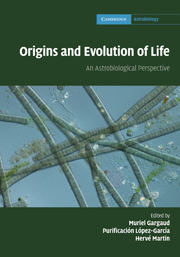Book contents
- Frontmatter
- Contents
- List of contributors
- Foreword
- Preface
- Part I What is life?
- Part II Astronomical and geophysical context of the emergence of life
- Part III The role of water in the emergence of life
- Part IV From non-living systems to life
- Part V Mechanisms for life evolution
- 19 Molecular phylogeny: inferring the patterns of evolution
- 20 Horizontal gene transfer: mechanisms and evolutionary consequences
- 21 The role of symbiosis in eukaryotic evolution
- Part VI Life in extreme conditions
- Part VII Traces of life and biosignatures
- Part VIII Life elsewhere?
- Index
20 - Horizontal gene transfer: mechanisms and evolutionary consequences
from Part V - Mechanisms for life evolution
Published online by Cambridge University Press: 04 February 2011
- Frontmatter
- Contents
- List of contributors
- Foreword
- Preface
- Part I What is life?
- Part II Astronomical and geophysical context of the emergence of life
- Part III The role of water in the emergence of life
- Part IV From non-living systems to life
- Part V Mechanisms for life evolution
- 19 Molecular phylogeny: inferring the patterns of evolution
- 20 Horizontal gene transfer: mechanisms and evolutionary consequences
- 21 The role of symbiosis in eukaryotic evolution
- Part VI Life in extreme conditions
- Part VII Traces of life and biosignatures
- Part VIII Life elsewhere?
- Index
Summary
Introduction
Human common experience tells us that the individuals of a particular species reproduce among themselves to produce a progeny which tends to resemble their parents. This inheritance of characters from one generation to the following one is known as ‘vertical inheritance’. Although the nature of the physical support of the genetic information transmitted through generations remained mysterious until 1944 when DNA was shown to constitute such support, Gregor Mendel had already described the laws that control this kind of inheritance in plants in the nineteenth century. The vertical inheritance of favourable modifications is one of the pillars of the Darwinian theory of evolution: natural selection can be effective only if the advantageous characters selected can be transmitted to the progeny. This central role of vertical inheritance in evolution was adopted later on in the twentieth century by the neo-Darwinian evolutionists. For example, they proposed the ‘biological species concept’, which states that a species is defined by the capacity of its members to reproduce among themselves, namely, a species concept that, instead of being based on morphological characters as in the classical definitions, was based on the capacity of vertical inheritance. In addition, the vertical transmission of the genetic information with changes due to selection defines evolutionary lineages of organisms that are distinct from the rest of the lineages (for example our own Homo sapiens lineage). As Darwin stated in his The Origin of Species, the evolutionary relationships between those lineages are best represented by a phylogenetic tree.
- Type
- Chapter
- Information
- Origins and Evolution of LifeAn Astrobiological Perspective, pp. 313 - 325Publisher: Cambridge University PressPrint publication year: 2011



